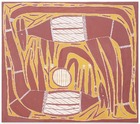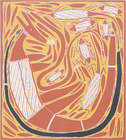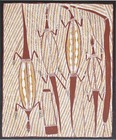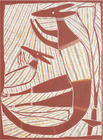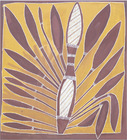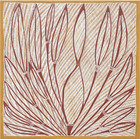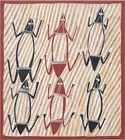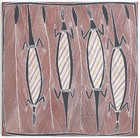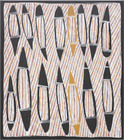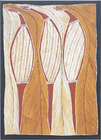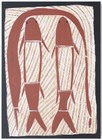Between 1979 and 1995, Bandjalung curator, writer, artist and activist, Djon Mundine, worked as resident art advisor on the island of Milingimbi and then at the newly-formed Bula’bula Arts centre in Ramingining, Arnhem Land in the Northern Territory. The cultural outcomes of his time there are unquantifiable however there are a few key landmarks of note.
In 1984, Mundine worked with the Power Gallery of Contemporary Art at the University of Sydney (pre-cursor to the Museum of Contemporary Art, Sydney) on the realisation of the exhibition Objects & Representations from Ramingining - the more than two hundred artworks from which were later acquired by the institution, accompanied by a progressive custodial agreement, as the Ramingining Collection. The Ramingining Collection, and Mundine’s founding curatorial work that had shaped it, supported by the insightfulness of incoming co-curators Bernice Murphy and Leon Paroissien, formed the foundation of the JW Power Collection and the MCA’s Aboriginal art collection.*
In 1988, Mundine developed a project to address the absence of any Australian memorial commemorating the massacres of Aboriginal people by white colonists on the 200th year anniversary of the commencement of these atrocities (which in many respects, as evidenced by statistics of black deaths in custody, vast disparities in socio-economic wellbeing and life-expectancy, destruction of sacred sites by mining corporations, near extinction of hundreds of languages etc., are ongoing today). Mundine worked with forty-three artists from Ramingining to produce a national Aboriginal memorial. Aboriginal Memorial, a forest of two hundred burial poles (dupun), was exhibited in the 1988 Biennale of Sydney and was acquired by the National Gallery of Australia, Canberra. Variously exhibited at the NGA over subsequent years, it has more recently been given a permanent location, sited in a specially-constructed double height space next to the new entrance.
In 1996, the Museum of Contemporary Art, Sydney presented an exhibition curated by Mundine, The Native Born: Objects and representations from Ramingining, Arnhem Land which later travelled internationally to the Pinacoteca do Estado de São Paulo (Brazil), the Palacio de Velázquez in Madrid (Spain), the Sprengel Museum in Hannover (Germany), the Museum of Contemporary Art in Taipei (Taiwan) and the Asia Society Museum in New York (USA). The 242-page catalogue that accompanied the exhibition has been published in four languages became a benchmark in the understanding of art from Central Arnhem Land, and this publication and the exhibition as a whole represented a maturation of contemporary art museum practice in Australia in its presentation of Aboriginal art. It is also an expression of Mundine’s agility as a cultural ambassador, born from his deep commitment gained over sixteen years in-residence with the Ramingining community, the many other curatorial projects he formed there and his distinction as an historian, a poet and an intellectual.
In 1993, Mundine received the Medal of the Order of Australia for service to the promotion and development of Aboriginal arts, crafts and culture. Between 2005 and 2006, he was resident at the National Museum of Ethnology (Minpaku) in Osaka (Japan) as a Research Professor in the Department of Social Research and is currently a doctoral candidate at UNSW Art & Design, within the University of New South Wales, Sydney. In 2020, the year before his 70th birthday, Mundine was made an Honorary Fellow of the Australian Academy of the Humanities and awarded the Australia Council for the Art’s Red Ochre Award for Lifetime Achievement.
During his sixteen years living at Milingimbi and Ramingining, Mundine developed close connections with Yolgnu artists especially those who participated in the curatorial projects mentioned above and others. One of these artists was Liyagalawumirr painter Philip Gudthaykudthay (pronounced ‘g’day, g’day’). Gudthaykudthay is also known by the nickname, ‘Pussycat’, after the Quoll (native cat) that is his totem (part of the Milky Way Dreaming) and other distinctive physical attributes. Mundine and Pussycat traveled together to attend ceremony all over Arnhem Land and the artist participated in each of the curatorial projects by Mundine mentioned above.
Pussycat (Philip Gudthaykudthay), born around 1935 or possibly some years earlier, is the senior living artist from Ramingining and one of the senior artists from the larger Central Arnhem Land area. Pussycat’s mother’s country is Ramingining. He paints both his mother’s and his father’s country. He started painting in the 1960s, taught by his half-brother Mirritja (Manbarra), initially selling his work through the Milingimbi mission. Some decades later, solo exhibitions of Gudthaykudthay’s bark paintings were held at commercial galleries in Sydney including Gary Anderson Gallery (1983) and Roslyn Oxley9 Gallery (1991). While now significantly elderly, Pussycat has still been active in recent months in ceremony within his community.
Philip Gudthaykudthay – The Pussycat and the Kangaroo is an exhibition curated by Djon Mundine of 23 paintings on canvas by Gudthaykudthay ranging in dates from 2005 to 2019. The exhibition is presented in association with Bula’bula Arts Aboriginal Corporation, Ramingining. It is a great honour for The Commercial to host this significant exhibition in Sydney on Gadigal land. The gallery offers deep thanks to Djon for its suggestion and realisation, to Mel George at Bula’bula for her enthusiasm and support and to Pussycat for sharing the experience of his art which we are humbled to present on the walls of the gallery.
The extraordinary energy of Pussycat's imagery – of Kangaroos, Wagilag Sisters, Goannas, Echidnas, Frogs, Sand Palms, Lilies, Yams in life-size - evolves in a number of distinct styles within the exhibition highlighted curatorially. Notably, Gandayala - the red kangaroo - is the creation ancestor of Ramingining and features prominently in the exhibition.
In 2007, Pussycat was paid tribute as one of a handful of especially significant artists in the inaugural Australian National Indigenous Triennial – Culture Warriors – curated by Brenda L. Croft at the National Gallery of Australia. The NGA acquired Pussycat's works from Culture Warriors for the collection. Pussycat’s Culture Warriors paintings are close stylistically to the works in the current exhibition. Gudthaykudthay's work is held in most state and many university galleries in Australia as well as the Australian Parliament House Collection. Internationally, his work is held in the collections of the British Museum, the Kluge-Ruhe Aboriginal Art Collection at the University of Virginia and the Seattle Art Museum.
Notable in Gudthaykudthay's biography is his prominent acting role in Rolf de Heer's award-winning film, Ten Canoes (2006), shot around Ramingining. In the catalogue for Culture Warriors, de Heer contributed a text about the artist who plays the part of The Sourcerer. De Heer describes Pussycat's depth of understanding of the traditional life being recreated in the film, his superior knowledge about making bark canoes, his septum piercing – an ancient cultural remnant no longer common - and his general energy, curiosity and enthusiasm for the film project. Excerpts from the film are viewable on YouTube at this link (Pussycat as Sourcerer 7.40 - 10.39).
In 1988, Philip Gudthaykudthay contributed five burial poles to the two hundred made by artists from Ramingining at Mundine’s invitation that form the Aboriginal Memorial, now located at the entrance to the National Gallery of Australia. They are part of the combined and enduring legacy of this artist and curator and part of a monument of national significance.
A text on the artist by Djon Mundine will be published during the exhibition.
---
*Much of the Power Collection has recently returned to the University of Sydney's new Chau Chak Wing Museum, where the Ramingining Collection is currently featured in the exhibition, Gululu dhuwala djalkiri: welcome to the Yolŋu foundations, on display until 21/11/21.















